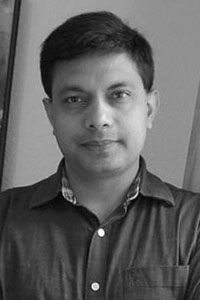IEEE Distinguished Lecture on Recent Advances in Dual-Blind Deconvolution for Joint Radar-Communications
The VT/COM joint chapter of the IEEE Benelux section are pleased to invite you to this IEEE Distinguished Lecture by Dr Kumar Vijay Mishra on the topic of "Recent Advances in Dual-Blind Deconvolution for Joint Radar-Communications" at the University of Luxembourg. This is a hybrid event with connection details in the flyer.
Date and Time
Location
Hosts
Registration
-
 Add Event to Calendar
Add Event to Calendar
- 29 Avenue J. F. Kennedy
- Luxembourg, Luxembourg
- Luxembourg 1855
- Building: SnT
- Room Number: E004/ Metz
Speakers
Dr. Mishra of University of Maryland, College Park under the US Army Research Laboratory ATIIAMAS program
Recent Advances in Dual-Blind Deconvolution for Joint Radar-Communications
Abstract: Recent interest in integrated sensing and communications (ISAC) has led to the design of novel signal processing techniques to recover information from an overlaid radar-communications signal. In this talk, we present a general spectral coexistence scenario, wherein the channels and transmit signals of both radar and communications systems are unknown at the receiver. In this dual-blind deconvolution (DBD) problem, a common receiver admits a multi-carrier wireless communications signal that is overlaid with the radar signal reflected off multiple targets. The communications and radar channels are represented by continuous-valued range-time and Doppler velocities of multiple transmission paths and multiple targets. We exploit the sparsity of both channels to solve the highly ill-posed DBD problem by casting it into a sum of multivariate atomic norms (SoMAN) minimization. We devise a semidefinite program to estimate the unknown target and communications parameters using the theories of positive-hyperoctant trigonometric polynomials (PhTP). Our theoretical analyses show that the minimum number of samples required for perfect recovery scale logarithmically with the maximum of the radar targets and communications paths rather than their sum. We show that our SoMAN method and PhTP formulations are also applicable to more general scenarios such as unsynchronized transmission, the presence of noise, and multiple emitters. We also examine this problem using extremal functions from the Beurling-Selberg interpolation theory. Toward the end of the talk, we will briefly touch upon our research on other ISAC topics.
Biography:
Kumar Vijay Mishra (S’08-M’15-SM’18) obtained a Ph.D. in electrical engineering and M.S. in mathematics from The University of Iowa in 2015, and M.S. in electrical engineering from Colorado State University in 2012, while working on NASA’s Global Precipitation Mission Ground Validation (GPM-GV) weather radars. He received his B. Tech. summa cum laude(Gold Medal, Honors) in electronics and communication engineering from the National Institute of Technology, Hamirpur (NITH), India in 2003. He is currently Research Scientist at the University of Maryland, College Park under the ARL-ArtIAMAS program; Technical Adviser to Singapore-based automotive radar start-up Hertzwell and Boston-based imaging radar startup Aura Intelligent Systems; and honorary Research Fellow at SnT - Interdisciplinary Centre for Security, Reliability and Trust, University of Luxembourg. Previously, he had research appointments at the United States Army Research Laboratory (ARL), Adelphi; Electronics and Radar Development Establishment (LRDE), Defence Research and Development Organisation (DRDO) Bengaluru; IIHR - Hydroscience & Engineering, Iowa City, IA; Mitsubishi Electric Research Labs, Cambridge, MA; Qualcomm, San Jose; and Technion - Israel Institute of Technology.
Dr. Mishra is the Distinguished Lecturer of the IEEE Communications Society (2023-2024), IEEE Aerospace and Electronic Systems Society (AESS) (2023-2024), IEEE Vehicular Technology Society (2023-2024), IEEE Geoscience and Remote Sensing Society (2024-2025), and IEEE Future Networks Initiative (2022). He is the recipient of the IET Premium Best Paper Prize (2021), IEEE T-AES Outstanding Editor (2021), U. S. National Academies Harry Diamond Distinguished Fellowship (2018-2021), American Geophysical Union Editors' Citation for Excellence (2019), Royal Meteorological Society Quarterly Journal Editor's Prize (2017), Viterbi Postdoctoral Fellowship (2015, 2016), Lady Davis Postdoctoral Fellowship (2017), DRDO LRDE Scientist of the Year Award (2006), NITH Director’s Gold Medal (2003), and NITH Best Student Award (2003). He has received Best Paper Awards at IEEE MLSP 2019 and IEEE ACES Symposium 2019.
Dr. Mishra is Chair (2023-present) of the Synthetic Apertures Technical Working Group of the IEEE Signal Processing Society (SPS) and Vice-Chair (2021-present) of the IEEE Synthetic Aperture Standards Committee, which is the first SPS standards committee. He is the Chair (2023-2026) of the International Union of Radio Science (URSI) Commission C. He has been an elected member of three technical committees of IEEE SPS: SPCOM, SAM, and ASPS, and IEEE AESS Radar Systems Panel. He has been Associate Editor of IEEE Transactions on Aerospace and Electronic Systems (2020-) and IEEE Transactions on Antennas and Propagation (2023-). He has been a lead/guest editor of several special issues in journals such as IEEE Signal Processing Magazine, IEEE Journal of Selected Topics in Signal Processing, IEEE Journal on Selected Areas in Communications, and IEEE Journal of Selected Topics in Applied Earth Observations and Remote Sensing. He is the lead co-editor of three upcoming books on radar: Signal Processing for Joint Radar-Communications (Wiley-IEEE Press), Next-Generation Cognitive Radar Systems (IET Press Radar, Electromagnetics & Signal Processing Technologies Series), and Advances in Weather Radar Volumes 1, 2 & 3 (IET Press Radar, Electromagnetics & Signal Processing Technologies Series). His research interests include radar systems, signal processing, remote sensing, and electromagnetics.
Email:

